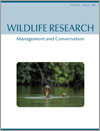Context . Exotic forestations may modify habitat quality, affecting native animal populations that require specific microhabitats to remain viable.
Aims . We determined whether abundances and body condition of the lizard species Liolaemus wiegmannii and L. multimaculatus differed between forested and non-forested dunes. We also examined what environmental attributes are important in explaining the potential differences.
Methods . We sampled six sites of 300 ha each. Three of these sites had original vegetation and three were forested with exotic Acacia longifolia. We traced 120 transects per site searching for lizards.
Key results . Lizards were two times more abundant in non-forested sites than in sites covered by acacia trees (even as low as a fourth of the area). Sites with high densities of acacia (≥78% of coverage) had the lowest abundance of lizards. In forested sites, the snout–vent length of L. wiegmannii was 10% smaller and relative body mass 22% lower than in non-forested sites. We found no differences in the body size of L. multimaculatus.
Conclusions . The replacement of the native vegetation by A. longifolia has negative effects on lizard species, representing a substantial threat to L. wiegmannii and particularly to L. multimaculatus, a threatened status species. Structural and thermal characteristics of the non-forested sites seemed to be more favourable for the abundance and body condition, whereas the dense vegetation and the low temperatures on the forested sites might explain the lower presence of lizards.
Implications . We recommend that before the implementation of future forestation plans in the pampasic coastal dunes, the deleterious consequences that this practice generates on native lizard fauna must be considered. When necessary, we recommend that A. longifolia be planted so that the coverage does not exceed a quarter of the total area, so as to prevent the formation of continuous (or closed) forest patches and to maintain the structural heterogeneity of the habitat that these lizards need to survive. In the most affected areas, eradication and control strategies may help reduce the advancement of this exotic plant over the areas intended for conservation.





